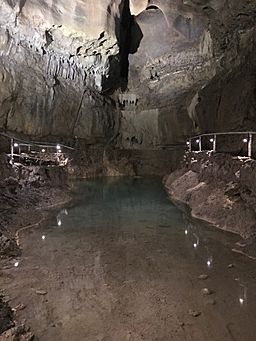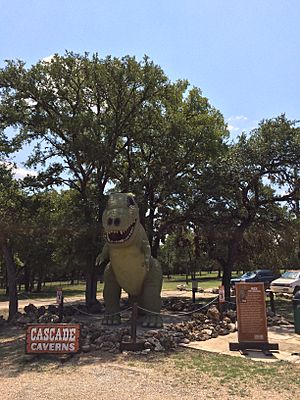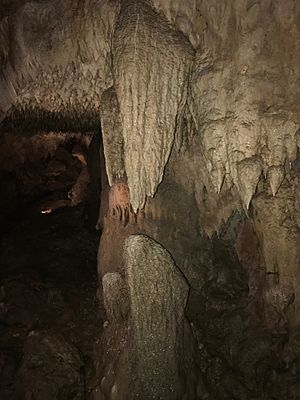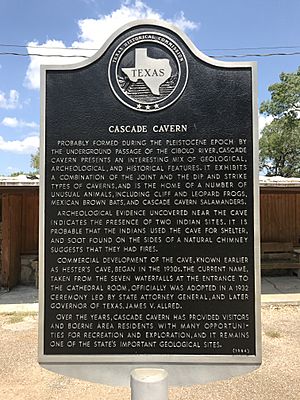Cascade Caverns facts for kids
Quick facts for kids Cascade Caverns |
|
|---|---|

Cascade Caverns Cathedral Room
|
|
| Location | Kendall County, Texas, United States |
| Depth | 132 Feet at Cathedral Room |
| Length | 1/2 mile |
| Discovery | Pre-1800 |
| Geology | Limestone |
| Difficulty | Beginner/Easy |
| Hazards | None |
| Access | Show cave |
| Show cave opened | 1932 |
| Website | http://www.cascadecaverns.com/ |
Cascade Caverns is an amazing limestone cave located about 3 miles south of Boerne, Texas, in Kendall County. It's been open for public tours since 1932, making it a popular show cave. But people knew about this cave much earlier! The native Lipan Apache people lived in this area before the 1800s and likely knew about the cave. Even in 1875, Dr. Benjamin Hester, who owned the land, gave informal tours.
Contents
A Look Back in Time
Cascade Caverns formed in a very old type of rock called the Glen Rose Formation. This rock formed from a shallow sea long, long ago, during the Lower Cretaceous period. You can find this type of rock all over the Texas Hill Country.
The cave has been open to the outside world for thousands of years! We know this because scientists have found bones of ancient animals and tools from the Lipan Apache people from the 1700s inside.
In the mid-1800s, there were stories about a mysterious person, a "hermit," who lived near the cave entrance. In 1878, a writer named August Siemering even wrote a book about a hermit living in the cave. It was later translated into English as The Hermit of the Cavern.
A cave in this area was also mentioned in a book called The Boy Captives. It told the story of two boys who were taken by Comanche and Lipan Native Americans in 1871. They lived with the tribes for several years before returning home. This cave might have been Cascade Caverns or another one nearby.
Opening for Visitors
Cascade Caverns first opened for tours in 1932. Alfred and Edith Gray were the first owners to open it to the public. The cave closed during World War II because many men were away fighting, and gas was hard to get. Sadly, during this time, many old artifacts were stolen from the gift shop. The cave reopened in the late 1940s.
Before it was called Cascade Caverns, it was known as Hester's Cave, named after an earlier landowner. It became famous thanks to Frank Nicholson, who explored many caves.
Frank Nicholson, who had also explored Carlsbad Caverns, was the first modern explorer to reach the deepest part of Cascade Caverns, called the Cathedral Room. Other explorers, like Bernard and Dan Cartwright, helped too. Bernard's wife, Mary Rose, remembered how they would worry while the explorers were deep inside the cave.
To explore the cave in 1931, they had to get past a flooded area called the Lake Room. They used waterproof buckets and even mason jars to protect their lights!
Over the years, many different people have owned the cave tour business. Back in the 1930s, a train even had a special stop near the cave entrance! The building that is now the gift shop used to be a dance hall. The famous Menger Hotel even ran a restaurant near the cave when it first opened. There was once a toy train, a swimming pool, a movie theater, and a fun "gravity house" on the grounds.
In 1967, an artist named Paul "P.B." Kime, who had a studio at Cascade Caverns, made a special parade float. It was used in the first Boerne Berges Fest parade and later in the first Weihnachts Parade.
In 1984, a special Texas historical marker was placed near the cave to celebrate its importance.

In 1993, the Walt Disney Company filmed parts of a movie called Father Hood at Cascade Caverns. Patrick Swayze starred in it! They filmed inside the cave and on the grounds for several weeks. A giant T. rex prop from the movie is still near the gift shop today.
Sadly, in 2002, a big flood badly damaged the original gift shop and destroyed a movie theater that had been built in 1984.
Exploring the Caverns
Cascade Caverns stays a cool 60 to 65 degrees Fahrenheit (15-18°C) all year round. The main tour takes about 45 to 60 minutes and covers half a mile of beautiful cave passages. You'll go 132 feet (40 meters) underground to reach the amazing Cathedral Room.
Below the Cathedral Room is another part of the cave. You can only reach it through a special drain pipe that was put in after a natural passage collapsed during a flood. Special "Adventure Tours" to this lower cave are given by expert cavers, but you need to book them in advance. The very bottom of the Lower Cave is about 230 feet (70 meters) below the surface!
Cascade Caverns was once famous for being the only cave in Texas with a natural waterfall inside. It used to have seven waterfalls! But a very long dry period in the 1950s caused most of them to dry up. The one in the Cathedral Room would either stop flowing or flood the room unexpectedly. So, in the 1960s, the original water source was sealed, and a new, artificial waterfall was put in. This way, visitors can still see the "cascading" water that gave the cave its name, without the risk of flooding. The cave is still very "alive," with water constantly dripping and helping the cave formations grow.
The most common formations you'll see are called soda straws. These are thin, hollow tubes that hang from the ceiling. Many of them are quite short because of past floods.
Cave Creatures
This cave is home to some really interesting creatures! You might see cave crickets and very rare cave beetles. There are also tiny creatures called amphipods. You might even spot amphibians, crawfish, and reptiles. Tricolored bats live here too.
One very special animal is the Cascade Caverns salamander. This unique salamander can only be found in Cascade Caverns and one other nearby cave called Cave Without a Name.
Scientists have found bones of ancient animals like mastodons (like woolly mammoths!), saber-toothed cats, and American bison in the cave. Native American tools and other old items were also found, but many of them disappeared when the cave was closed in the early 1940s.

Tours run all year, only closing rarely because of floods. A special dam helps protect the cave from sudden flash floods. Flooding has always been a part of the cave's history, helping to carve out its passages over time. In 1931, explorers even reported seeing white fish in the cave! After the dam was built, these fish were no longer seen.
Flooding at Cascade Caverns
Over the years, Cascade Caverns has experienced many floods. Water is a powerful force that helped create the cave, but it can also cause damage. Here are some of the major floods that have affected the area:
- 1900, September 9-10: A big hurricane brought over 12 inches of rain.
- 1921, September 7-11: This flood brought almost 40 inches of rain and caused many deaths in San Antonio.
- 1932, July 1-2: Over 30 inches of rain fell in the Guadalupe River Basin.
- 1972, May 11-12: This flood brought over 30 inches of rain to the New Braunfels-Seguin area.
- 1978, August 1-4: Known as the "500 Year Flood," it brought up to 46 inches of rain and caused many deaths in nearby counties.
- 1987, July 16-17: This flood was linked to the tragic Comfort Bus accident, where 10 students died.
- 2002, July 1-7: Over 28 inches of rain fell, damaging the old gift shop and destroying the movie theater at the caverns.
Images for kids
See also
 In Spanish: Cavernas Cascada para niños
In Spanish: Cavernas Cascada para niños










